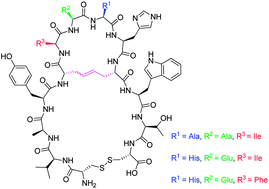Pseudopeptides with a centrally positioned alkene-based disulphide bridge mimetic stimulate kallikrein-related peptidase 3 activity†
Abstract
Pseudopeptides based on the kallikrein-related peptidase 3 (KLK3) activating bicyclic

Maintenance work is planned for Wednesday 1st May 2024 from 9:00am to 11:00am (BST).
During this time, the performance of our website may be affected - searches may run slowly and some pages may be temporarily unavailable. If this happens, please try refreshing your web browser or try waiting two to three minutes before trying again.
We apologise for any inconvenience this might cause and thank you for your patience.
* Corresponding authors
a
Division of Pharmaceutical Chemistry, Faculty of Pharmacy, University of Helsinki, Helsinki, Finland
E-mail:
erik.wallen@helsinki.fi
b School of Pharmacy, Faculty of Health Sciences, University of Eastern Finland, Kuopio, Finland
c Department of Clinical Chemistry, University of Helsinki and Helsinki University Central Hospital, Helsinki, Finland
d Medicinal Chemistry, Department of Chemistry and Molecular Biology, University of Gothenburg, Gothenburg, Sweden
Pseudopeptides based on the kallikrein-related peptidase 3 (KLK3) activating bicyclic

 Please wait while we load your content...
Something went wrong. Try again?
Please wait while we load your content...
Something went wrong. Try again?
K. Meinander, J. Weisell, M. Pakkala, A. C. Tadd, C. Hekim, R. Kallionpää, K. Widell, U. Stenman, H. Koistinen, A. Närvänen, J. Vepsäläinen, K. Luthman and E. A. A. Wallén, Med. Chem. Commun., 2013, 4, 549 DOI: 10.1039/C3MD20292E
This is an Open Access article. The full version of this article can be posted on a website/blog, posted on an intranet, photocopied, emailed, distributed in a course pack or distributed in Continuing Medical Education (CME) materials provided that it is not used for commercial purposes.
To request permission to reproduce material from this article in a commercial publication, please go to the Copyright Clearance Center request page.
If you are an author contributing to an RSC publication, you do not need to request permission provided correct acknowledgement is given.
If you are the author of this article, you do not need to request permission to reproduce figures and diagrams provided correct acknowledgement is given. If you want to reproduce the whole article in a third-party commercial publication (excluding your thesis/dissertation for which permission is not required) please go to the Copyright Clearance Center request page.
Read more about how to correctly acknowledge RSC content.
 Fetching data from CrossRef.
Fetching data from CrossRef.
This may take some time to load.
Loading related content
